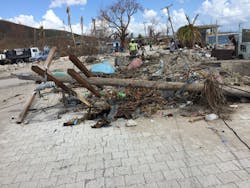Microgrid Rebuilding Continues as Haiti Struggles to Recover from Hurricane Matthew
Microgrid rebuilding continues in Haiti as the nation struggles to emerge from the rubble left from Hurricane Matthew’s devastating blow October 4.
Damage from Hurricane Matthew. Source NRECA
The Virginia-based National Rural Electric Cooperative Association (NRECA) is mounting an effort to repair a microgrid in Coteaux pummeled by Hurricane Matthew, leaving the 1,200 co-op members it served without power for an expected two months or longer.
Meanwhile, an affiliate of California-based Sigora International, which has been in Haiti since 2015, was able to restore power to its Mole project in 55 hours. Now the Sigora team also is distributing food, water purification tablets, roofing and other necessities.
“As a company working in Haiti, we have a responsibility to its people. If you are serving a certain market, you need to be involved in restoring the well-being of those communities.” said Andy Bindea, CEO of Sigora.
The organization has launched a go-fund-me campaign to raise money for relief, which it says has been slow to reach remote areas of Haiti.
Washington, D.C-based EarthSpark is trying to raise money for microgrid rebuilding in Les Anglais, where its project lost 25 percent of its solar panels during the Category 4 hurricane.
NRECA, too is raising money for its particularly hard hit solar/diesel microgrid. Following the storm, it took NRECA’s team 17 hours by pickup, motorcycle, and foot to reach the site.
Built with the help of 38 volunteers from 20 rural co-ops associated NRECA, the microgrid had been operating only about 13 months before the hurricane hit, destroying much of the solar array and tilting or leveling 70 percent of the distribution poles, said Zuraidah Hoffman, spokeswoman for the association.
The microgrid, funded through a $1.2 million United Nations Environmental Program grant plus $250,000 from the rural electric association, included two diesel generators rated at 120 kW and 250 kW, plus a 143- kW solar array, said Dan Waddle, senior vice president for NRECA.
The local cooperative –- Cooperative Electrique de l’Arrondisement des Coteaux–began operating the microgrid in September 2015, serving the towns of Port a Piment, Coteau, and Roche a Bateaux.
The coop volunteers and others plan to begin rebuilding in about two months, said Waddle.
Designed to withstand 150 MPH winds, but…
The NRECA microgrid was designed to withstand 50-year storms and winds of up to 150 MPH, and the solar system’s racking system should have withstood the force of the winds, he said. However, the wind traveled up a south-facing hill where the array was located, and it’s possible the winds accelerated up the hill, he said.
If the designers had known the storm was coming, they may have changed the solar system’s racking system, Waddle said.
“Mostly what we have to do is clean up the materials on the ground and make sure the streets are safe to walk on,” Waddle said. “About 35 percent of the houses are habitable.” Workers can begin reconnecting the households and a the few co-op businesses members to the microgrid after the distribution system is working.”
Even before the storm hit, NRECA began receiving emails from the linemen who had helped build it, offering in advance to help with microgrid rebuilding.
Source Sigora
When NRECA helps build microgrids or other systems in communities with no electricity, the association encourages a co-op model, said Waddle. Under this model, the co-op starts with a small amount of member capital, generally $5 to $50 per member in developing countries.
The co-op is owned by the members and each member has an equal share of equity in the system and has one vote in elections, he said. The members elect a board of directors who establish policies and hire managers.
Microgrids and other forms of electrification over the long-term provide positive economic impacts, Waddle said. At first, the community members benefit from the lower cost of lighting power because the kerosene generally used for lighting is more expensive. They also use the electricity for cell phone charging, water supplies, and using household appliances. Over time they use it to generate income.
“It’s not just a matter of learning how to generate income but the community members need to get money to purchase equipment, “Waddle explained. For example, they might need to purchase milk chillers for selling milk.
Given its lack of electrification and remote areas, Haiti is considered a prime candidate for microgrids. NRECA also is focused on microgrids in areas of Africa where there is no central transmission system.
Track news about rebuilding microgrids in Haiti by subscribing to the Microgrid Knowledge newsletter. It’s free.
About the Author
Lisa Cohn
Contributing Editor
I focus on the West Coast and Midwest. Email me at [email protected]
I’ve been writing about energy for more than 20 years, and my stories have appeared in EnergyBiz, SNL Financial, Mother Earth News, Natural Home Magazine, Horizon Air Magazine, Oregon Business, Open Spaces, the Portland Tribune, The Oregonian, Renewable Energy World, Windpower Monthly and other publications. I’m also a former stringer for the Platts/McGraw-Hill energy publications. I began my career covering energy and environment for The Cape Cod Times, where Elisa Wood also was a reporter. I’ve received numerous writing awards from national, regional and local organizations, including Pacific Northwest Writers Association, Willamette Writers, Associated Oregon Industries, and the Voice of Youth Advocates. I first became interested in energy as a student at Wesleyan University, Middletown, Connecticut, where I helped design and build a solar house.
Twitter: @LisaECohn
Linkedin: LisaEllenCohn
Facebook: Energy Efficiency Markets

